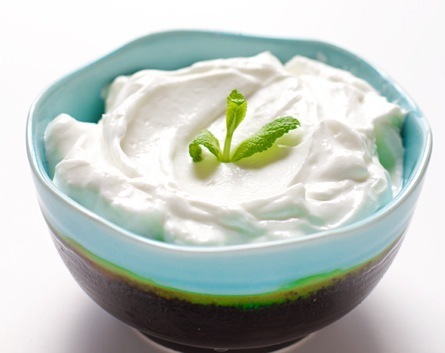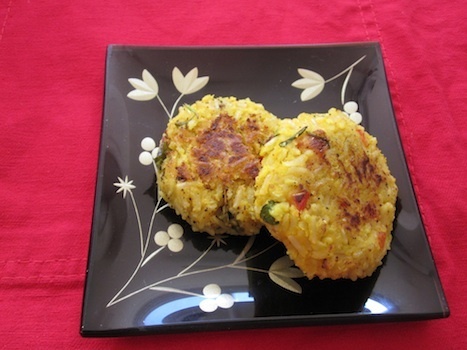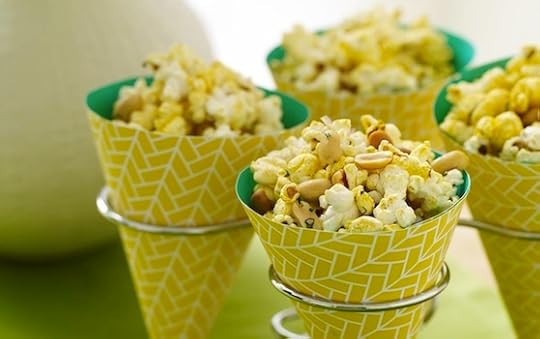Monica Saigal Bhide's Blog, page 18
July 28, 2014
Saffron and yogurt chicken
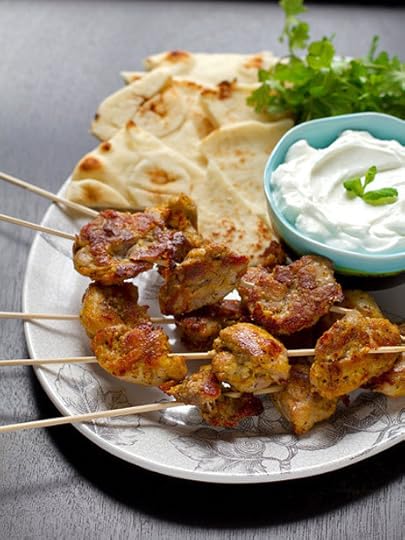
Sala Kannan thanks for a great shot!
Makes 6 servings, 2 or 3 skewers per person
1/4 cup plain low-fat yogurt, drained*
2 tablespoons finely ground almonds
1/4 cup grated cheddar cheese
1 tablespoon grated, peeled fresh ginger
1 teaspoon fresh lemon juice
1 teaspoon ground white pepper, or to taste
1 teaspoon salt
1/2 teaspoon saffron threads, soaked in 2 tablespoons warm milk
2 1/2 pounds skinless, boneless chicken thighs, cut in 1 1/2-inch cubes
Combine the yogurt cheese, almonds, cheddar, ginger, lemon juice, pepper, salt, saffron and milk in a large bowl. Add the chicken and mix to thoroughly coat. Cover and refrigerate for 5 to 6 hours or overnight.
Preheat oven to 400 degrees.
Drain chicken and discard any remaining marinade. Thread the chicken onto skewers, 4 or 5 pieces per skewer.
Lay the skewers on a nonstick baking sheet and roast for 10 minutes. Turn over. Roast another 10 to 15 minutes, until golden brown and juices run clear. Serve hot.
* To drain the yogurt: Place a colander over a medium bowl. Line the colander with several layers of cheesecloth. Place yogurt in cheesecloth. Refrigerate at least 8 hours, until whey has drained out (overnight works best).
The post Saffron and yogurt chicken appeared first on Monica Bhide | Recipes, Stories, Inspiration.
July 21, 2014
Yogurt Drink with Cumin
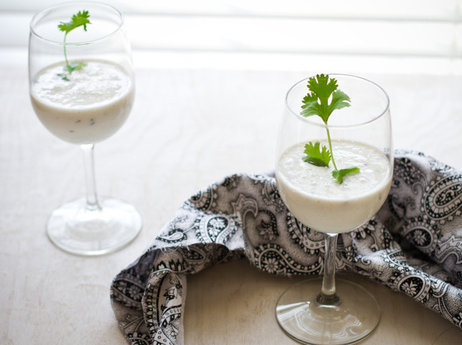
Sala Kannan, thanks for a great shot
Makes 4 servings
3 cups Greek-style yogurt
1 cup water
1/2 teaspoon ground toasted cumin
1 small green serrano chili, minced (optional)
1/2 teaspoon minced fresh ginger
1/2 teaspoon salt, or to taste
1 teaspoon chopped mint
1 tablespoon chopped cilantro
Tadka
1 teaspoon ghee* or grapeseed oil
1/2 teaspoon cumin seeds
1/2 teaspoon chopped garlic
1/4 teaspoon minced green chili such as jalapeno
Whisk the yogurt with the water until smooth. Add the ground cumin, chile, ginger and salt and mix well. Pour into four glasses.
To make the tadka, heat the ghee in a small pan until it shimmers. Add the cumin seeds. When the cumin darkens and gets aromatic, add the garlic. When the garlic starts getting golden at the edges, add the chili. Fry until the chili begins to darken but not burn.
Pour the tadka over each portion. Serve garnished with the chopped mint and cilantro.
*Available at Indian markets
The post Yogurt Drink with Cumin appeared first on Monica Bhide | Recipes, Stories, Inspiration.
July 14, 2014
Yogurt Rice
The ultimate Indian comfort food: Leftover rice is combined with beaten yogurt and topped with a sizzling tempering of curry leaves, mustard seeds and red chilis. This recipe uses whipped yogurt: Place the yogurt in a bowl and use a fork to mix it well. This incorporates the milk part with the whey and gives a smooth consistency to the yogurt.
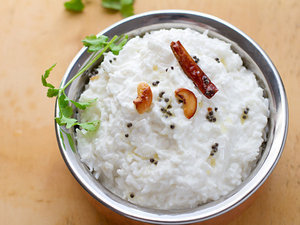
Sala Kannan, thanks for the great shot!
Makes 6 servings, 1/2 cup per person
2 cups basmati rice
1 teaspoon salt
1 tablespoon vegetable oil
1 cup plain low-fat yogurt, whipped
1 cup buttermilk
1/2 cup diced green mango
2 tablespoons minced cilantro
2 tablespoons clarified butter (ghee) or vegetable oil
1 teaspoon black mustard seeds
2 whole dried red chilies, any size
15 to 20 curry leaves (available at Indian markets)
1-inch piece fresh ginger, peeled and julienned
1/4 cup unsalted raw cashews
Rinse rice at least twice, until the water runs clear. Drain well.
Bring rice and 4 cups fresh water to a boil in a deep saucepan. Add salt and oil. Reduce heat to low and loosely cover. Cook 12 to 15 minutes, until all the water has been absorbed. You will see small craters forming on top of the rice.
Remove from heat. Let cool to room temperature, about 2 hours.
Combine rice with the yogurt, buttermilk, green mango and cilantro. Mix well and place in a serving bowl.
Heat clarified butter in a small skillet over medium heat. Add mustard seeds. When they begin to sputter, in quick succession, add the chilies, curry leaves, ginger and cashews. Mix well. Saute 1 minute, until the cashews begin to brown.
Pour spice mixture over the rice. Serve immediately.
The post Yogurt Rice appeared first on Monica Bhide | Recipes, Stories, Inspiration.
July 7, 2014
Summer Yogurt Sauce
If you know anything about me, you know that I love to make simple dishes that are flavorful and dont need a ton of “fussing”. Here is a simple dish using yogurt that can really add a lovely touch to a summer bbq. If you dont have lemon extract, just use the zest of one lemon.
Thanks to Reem Rizvi for the gorgeous photo of the sauce.
Monica’s summer yogurt sauce
2 cups low fat yogurt (like Olympus Greek Strained Yogurt)
1 teaspoon cracked black pepper
2 tablespoons olive oil
1/2 teaspoon lemon extract (be careful it can be intense)
½ teaspoon ground cardamom
1 tablespoon chopped chives
Salt and pepper to taste
Toasted pine nuts for garnish
Place the yogurt in a small bowl and add a few tablespoons of water. Mix well to remove any lumps and thin out the yogurt. Mix it until it is smooth and creamy in texture.
Add the remaining ingredients (except the pine nuts). Taste and season as needed.
Garnish with the pine nuts and enjoy.
I love to serve this simple dish as a side to grilled vegetables or grilled meats in the summer.
(Photo shows some of the olive oil and chives used as garnish as well)
The post Summer Yogurt Sauce appeared first on Monica Bhide | Recipes, Stories, Inspiration.
July 2, 2014
Yogurt, without the fuss
Here is my simple recipe for home-made yogurt. Make it, love it, own it.
Thanks to Sala Kannan for this photo
Bring about 1 quart of milk to a boil. You can do this on the stove top or in the microwave.
Remove from the heat and pour the milk from the pot into a storage container. Set aside to cool.
Do the pinkie test: If you can touch the milk comfortably with your pinkie for 30 seconds, it’s ready for the culture. You can also use modern technology and check the temperature with an instant-read thermometer. It should register just warm, 110 to 112 degrees.
Add about 2 tablespoons of plain, unflavored yogurt, stir, and cover the container. This is called a starter yogurt as it helps you start a new batch.
Wrap container snugly with a large towel.
Place the container in a warm spot. An oven with a pilot light is ideal. Alternatively, place it inside the microwave.
Let this sit undisturbed for at least 7 hours. Overnight works best. During winter months, I find that it has to sit longer.
To check if the yogurt is set, remove the towel and lid and very gently shake the container to see if the yogurt is firm. If not, it needs to sit for a few hours longer.
If it has set, place the container in the refrigerator to chill.
There’s More To Okra Than Frying Feb. 23, 2011
Why I Don’t Cook For My Parents Nov. 10, 2010
Why The Priest Fainted: An Ode To EggplantSept. 8, 2010
Into The Mouths Of Babes: The Foods That Bind May 5, 2010
That is it. Simple, easy and no stabilizers or preservatives or sweeteners added — or needed.
The post Yogurt, without the fuss appeared first on Monica Bhide | Recipes, Stories, Inspiration.
June 27, 2014
The Quantified Author: Lessons from my food writing career
In April of 2014, I wrote a story for the ASJA magazine on the lessons I have learned over the last ten years as a food writer. Today, I would like to share that story with you all. I look forward to hearing your feedback, insights and advice as I embark on my next writing decade and adventure!
[image error]
Ten years, powered by hope
It was a beautiful Monday morning in January 2004 when I decided to quit my job, which paid very handsomely—six-figure salary, great insurance, the ability to travel the world—to embark on a new career I knew nothing about. I wanted to become a writer. So many people still ask me how I made the choice. But those of you reading this know that it is not a choice, it simply is. Giving in to the deepest desire of your heart to tell stories is a calling. And once it takes hold of you, it does not let go.
An engineer by training and trade, I decided to draw up a plan and study the markets. After all, there had to be a science behind how successful writers got there. In hindsight, I wish I could say that I was really that young and that stupid, but I wasn’t. I was a thirty-five-year-old engineer with two masters degrees in information systems. I had studied the way the brain works. I was sure there was a way and I could find it. I even wrote my obituary, to discover exactly how I wanted to be remembered.
The question: what to write about, was the easiest one. I wanted to tell stories about life and, being a lover of all things edible, I naturally gravitated towards using food as an lens to do so.
The first thing I discovered was that I needed to get big bylines—I needed the New York Times, the Washington Post, Saveur, Gourmet, Bon Appétit, Food & Wine, all the big boys in my chosen new world of food writing. Once I had those, I would be able to get a book contract and then, you know, retire to write my stories at will and leisure.
What followed was ten years of battle scar–worthy attempts at becoming a writer, and today I share them with you with great pride. I have a theory that it takes ten years to become an overnight success, so this January, I will either be writing my dream book or banging my head against the wall—both of which are, as you know, the same thing.
Lessons Learned
It took me six months of “convincing” the Grey Lady, the NY Times, to let me write a story for them. I begged, prayed, wrote detailed proposals, sent lists of potential interviewees with quotes. Everyone told me I was being a fool and that the Times would never bite. This brings me to lesson number one: just as I don’t know what sells or works in this industry, no one else does, either. The Times bought the story and ran it on the front page of the food section, above the fold.
My second lesson came from a luxury food magazine. I went to their New York City offices, terribly nervous. I pitched the features editor totally inane front-of-the-book pieces. She listened for a while and then asked, “What do you really want to write?” I told her. I was paid handsomely to travel across the world and write the story about the food culture of a newly burgeoning metropolis. When I filed it, the editor said it was the most poetic piece she had ever read. Then they sent a photographer across the world to shoot the story. All was going swimmingly well. The day before the story was to run, after six months’ worth of work, it was killed. No reason was provided. I learned how to negotiate and get paid for a killed piece, but more important, I learned that nothing is guaranteed until the story is already in print.
With my stories under my belt, I pitched a book. The first rejection said the book needed essays. The next rejection, a week later, asked me to take the essays out of the book. Four rejections later, the book was accepted. The week the cookbook came out, the acquiring editor quit and it came out that the in-house publicist had never promoted a cookbook before. Needless to say, the retirement plans needed to be pushed back. And my lesson became that even when you get your best stuff in print, there are no guarantees of success.
At this point, I pitched a newspaper a story and the editor, who was well aware of my bylines and books, asked me what the traffic was like on my blog. Blog? I had a website but no idea what a “blog” was. He insisted I create one in order to get more work. I did—and learned that I had created a monster that constantly needed to be fed but provided low or no returns.
This is when my focus turned from telling stories to creating a brand and a persona so that I could get magazines to assign me work.
I think the final lesson came when I was at dinner with a major magazine editor and she asked me for my Klout score. I had to excuse myself, praying that the bathroom had Wi-Fi, and check on my phone what the heck Klout was.
Publishing was changing faster than I could keep up, everything was about traffic and numbers, and everything was focused on brand. I should know—I began to teach sold-out seminars on these very topics.
In September 2013, my younger son started first grade. He was curious about what people did for a living and asked me. I told him I was a writer and he said, “So like you write on Facebook?”
That innocent yet insightful comment threw me for a serious loop. Who was I? What did this business really mean to me?
I went back and looked at my original notes from ten years earlier and yes, this recovering engineer found the obituary she had written back then when embarking on this new life. I read it again and this time, I decided to actually focus on what I wanted to be instead of what the market was demanding.
My obituary said, “Monica was a writer who told stories of hope and inspiration. She aspired to help people achieve their goals and dreams. Her stories were often told through the focus of food.”
Considering I am not dead yet, I have another chance to make this work. My challenge is to fit this into this new world of social media craziness, branding, writing, and being who I really want to be.
In January 2014, I launched my own digital project, “Powered by Hope,” to share what I have learned over the ten years of creating this new life.
These ten years have taught me a lot about life: the need for tenacity, the value of support systems, the lessons of failure, and how the years I have spent in the pursuit of my dream truly have been powered by hope.
This digital project, free to all my readers, is about making my mess my message. Each week, readers will get a story intended to be motivational, but mostly meant to get people thinking. It has all the elements of social media but more important, it has a writer telling stories.
I am not sure where it will lead, but that is the most important lesson of all from my journey: the journey itself, with its ups and downs and joys and sorrows, is the most rewarding part. The destination, if it doesn’t change a million times, is just a stopping point where you ask, “Where to now?”
The post The Quantified Author: Lessons from my food writing career appeared first on Monica Bhide | Recipes, Stories, Inspiration.
June 26, 2014
Chickpea Burgers
Adapted from “The Cancer-Fighting Kitchen: Nourishing, Big-Flavor Recipes for Cancer Treatment and Recovery,” by Rebecca Katz with Mat Edelson (Celestial Arts, 2009).
These chickpea burgers are similar to a Middle Eastern falafel. But the Americanized version of falafel usually resembles carnival food: they’re often deep-fried.
Here the secret ingredient is basmati rice, which holds the chickpea mixture together and helps create a complete protein. Gently pan-seared or baked, these burgers are bountiful, healthful bites, especially good when topped with a dollop of tomato-mint chutney.
MAKE AHEAD: The baked burgers can be refrigerated for 3 to 5 days. To freeze these burgers, either cooked or uncooked, stack them with parchment paper between each one, then wrap in plastic wrap and aluminum foil. Once defrosted, cooked burgers can be reheated at 350 degrees for 15 minutes, and uncooked burgers can be baked at 375 degrees for 22 to 25 minutes.
SERVINGS: 17 SMALL PATTIES
INGREDIENTS
2 cups cooked chickpeas (may substitute a 15-ounce can of chickpeas, drained, rinsed and mixed with a spritz of freshly squeezed lemon juice and a pinch of sea salt)
1/2 teaspoon sea salt
1/2 teaspoon ground turmeric
1/2 teaspoon sweet paprika
1/4 teaspoon ground cumin
1/4 teaspoon ground coriander
1/8 teaspoon ground cinnamon
1 or 2 small cloves garlic, minced (2 teaspoons)
1/2-inch piece peeled ginger root, minced (1 teaspoon)
3 tablespoons extra-virgin olive oil
2 tablespoons freshly squeezed lemon juice
2 1/2 cups cooked brown basmati rice
3 tablespoons finely diced red bell pepper
Leaves from 1/3 bunch flat-leaf parsley, minced (1/4 cup loosely packed)
DIRECTIONS
Preheat the oven to 375 degrees. Line a baking sheet with parchment paper.
Combine the chickpeas, salt, turmeric, paprika, cumin, coriander, cinnamon, garlic, ginger, oil and lemon juice in a food processor; process until smooth, scraping down the sides of the bowl as needed. Transfer the mixture to a bowl and fold in the rice, bell pepper and parsley.
Moisten your hands to keep the mixture from sticking to them, then shape the mixture into seventeen 1/4-inch-thick patties about 2 1/2 inches in diameter. Place them on the prepared baking sheet and bake for 22 to 25 minutes, until the patties start to look crisp on the outside. They will firm up as they cool.
VARIATION: For a crispy burger, heat 2 teaspoons of olive oil in a skillet over medium heat and cook the patties for about 3 minutes on each side, until golden brown.
The post Chickpea Burgers appeared first on Monica Bhide | Recipes, Stories, Inspiration.
June 24, 2014
Freak Show Without a Tent by Nevin Martell
Please join in me congratulating my friend and fellow writer, Nevin Martell, on the release of his terrific new book: Freak Show Without a Tent. I really adore Nevin’s writing and his sense of humor in particular. This book captures it all. First of all the story is really magnificent and then you put it in the hands of a talented writer and you have the perfect combination — a book that you cannot put down. It is a terrific read and I highly recommend it.
I asked Nevin to tell his a little bit about his experience “Behind the Book”:
Behind the Book:
Freak Show Without a Tent: Swimming with Piranhas, Getting Stoned in Fiji and Other Family Vacations
By Nevin Martell

A good book rarely ends the way the reader expects.
The same is true for authors. Despite the fact that I plot out my books meticulously, the finished product is oftentimes markedly different than my initial plan. Over the course of working on a project for a year or more, I find new angles, realize that certain elements don’t work on the page and decide to explore previously unconsidered storylines.
This was especially true of my memoir-misadventure Freak Show Without a Tent: Swimming with Piranhas, Getting Stoned in Fiji and Other Family Vacations, which is being published on June 24 by Washington, DC-based Possibilities Publishing. You would think that I would have known exactly how it was going to end, since it’s the story of my life. Nothing could be further from the truth.
When I finished the first draft, I knew the book needed work. Some of the chapters had strong individual arcs, but the overarching themes and their conclusions weren’t present. My second draft further strengthened the chapters and the new ending summed up the story as neatly as I thought possible. It still wasn’t there though, so I passed off the manuscript to a few writer friends for feedback.
One pointed out that the book was essentially a father-son story. Unfortunately, my second draft didn’t emphasize that parent-child subtext enough and the overall story ended on a falsely negative note. The final pages didn’t properly summate how far my Dad and I had come as adults or the richness of our relationship.
With just a couple of weeks before my final deadline, I decided to add a new final chapter and completely rewrite the epilogue. It was a daunting proposition. I had already poured so much blood, sweat and tears onto the page, but I knew I had to wring more out of myself if I wanted to get the story right.
Those were the two most hellish weeks of my life, but also the most rewarding. When I finally sent off the third and final draft of Freak Show Without a Tent to my editor, I felt like the story had come full circle. It didn’t end the way I’d thought it would, but I was happily surprised by the outcome.
Below you’ll find the first two pages of my original epilogue, which recount a trip I took with my wife, Indira, to the Bay Islands off the coast of Honduras. You’ll have to buy Freak Show Without a Tent to find out how the book ends now.
******** BY NOW - Freak Show Without a Tent ********
—
“You expect me to fly in that thing?”
My fiancée delivered the last two words with fear and astonishment.
I peered out on the tarmac at that thing in question – a single engine Cessna plane. Running an experienced eye over it, I went down my usual checklist.
Wheels? Present, accounted for and devoid of any visible cracking to the rubber.
Wings? Firmly attached and lacking any duct tape applied to critical junctures.
Frame? The paint was slightly scratched in places, but the metal body was without any punctures.
Windows? Check!
Was there a complicating factor I wasn’t considering? Speaking to the pilot earlier, I hadn’t detected the hint of alcohol on his breath; his pupils weren’t dilated; his handshake was firm and steady.
I scanned the sky. Not a cloud in it. Just endless blue.
Cocking an ear towards the line of palm trees ridging the runway, I couldn’t hear the crackle of rifle fire from an advancing horde of counterrevolutionaries. There was the decelerating roar of a landing plane and the squeak of its tires hitting the tarmac, but nothing else.
A quick sniff didn’t turn up the smell of leaking diesel or brake fluid. Actually, it smelled beautiful – pungent tropical air rich with moisture and life.
I was confused. “What’s wrong with it?”
There was thunderous silence, followed by an incredulous “Do I really need to explain everything to you?” look that I would become very familiar with as the years went on.
“It’s tiny!” she exploded, her artfully coiled braids shaking in a flurry of black. “Is there enough room for us and our luggage?”
I briefly wondered if Indira was regretting saying yes to my marriage proposal. From her body language, it seemed like all the diamonds in the world might not be enough to coax her on board. She was straining away from the plane like a dog on the end of a leash.
I didn’t want to point out that there was no way we were going to turn around and go home. That tiny puddle jumper was our only way forward. We were on Roatán, the largest of the Bay Islands, just off the northern coast of Honduras. Our final destination was its sister island Utila, where we were planning to spend a week commemorating our engagement. I only planned on getting married once, so I wanted every step of the way to be picture perfect. In order for us to indulge in all the romance, see all the radiant sunsets, and enjoy all the relaxing afternoons on the beach that I was imaging, Indira had to get on that pint-sized plane – preferably of her own volition.
“That’s not the smallest airplane I’ve ever been in,” I tried with what I hoped was a charming and disarming smile.
“Really?” She shot back. “Where’d you sit? The pilot’s lap?”
Okay, so that particular line of reasoning wasn’t going to work.
“It looks like it’s in great condition,” I argued. “This is nothing like the flying coffin we flew in Vanuatu. Now that plane was fucked up.”
Indira stared hard at me, her brown eyes blazing. “Is that supposed to make me feel better? That plane is absolutely unrelated to this one and therefore has no bearing on this case.”
Now that I thought about it, was I absolutely sure that I wanted to marry a lawyer? When we argued, she had a parry for my every thrust.
I played the only card I had left in my deck. “You’re going to have to trust me,” I said slowly and carefully, like I was negotiating a hostage release.
The fire in Indira’s eyes went from volcanic red to cobalt blue, but kept smoldering. She set her chin just so and stared at me intently.
“I’ll be right next to you the whole time,” I continued. “You don’t even need to keep your eyes open while we’re flying if you don’t want to.”
I pulled her in for a hug. “C’mon, it’ll be fun. Something we can tell our kids about. Did I ever tell you about that time my father tried to make me swim with piranhas in the Amazon?”
—

Nevin Martell is a D.C.-based food, travel, and lifestyle writer whose work regularly appears in the Washington Post, Plate, Wine Enthusiast, and NPR’s blog “The Salt.” He is the author of six books, including the memoir-misadventure Freak Show Without a Tent: Swimming with Piranhas, Getting Stoned in Fiji and Other Family Vacations (2014), The Founding Farmers Cookbook: 100 Recipes for True Food & Drink (2013) and the small-press smash Looking for Calvin and Hobbes: The Unconventional Story of Bill Watterson and his Revolutionary Comic Strip (2009). Find him online at nevinmartell.com and on Twitter @nevinmartell.
The post Freak Show Without a Tent by Nevin Martell appeared first on Monica Bhide | Recipes, Stories, Inspiration.
June 18, 2014
Masala Popcorn
So instead of a recipe, here is an OLD video of me showing how to make these
Photo courtesy Tina Rupp
The post Masala Popcorn appeared first on Monica Bhide | Indian Recipes, Cuisine, Cooking with Spices.
June 17, 2014
Food Bloggers Connect Conference 2014, London
A few weeks ago, I was in London for the Food Bloggers Connect Conference. I was an invited speaker and presented several different workshops on the art of writing with your senses, to working with brands and sponsors, to creating powerful media packs. I enjoyed every single minute of this fantastic conference – I got to meet old friends like Luisa Weiss, learn about photography from the AMAZING Marie Forsberg, meet a dear friend and student in person - Luca Marchiori and of course, meet so many wonderful bloggers from across Europe.
Oh, and I wanted to share this.. this was the response to my workshops from the creators of the conference – Bethany and Joslin Kehdy – “Moncia Bhide is one of the best speakers we’ve had the pleasure of working with. Fun and cheerful, she also has a passionate delivery of knowledge and inspiring wisdoms that keep the audience spellbound. Everyone’s still raving about her and we want her back. “
Feedback coming in from the students:
“I attended Monica’s classes and talk at the Food Blogger Connect. Monica is funny, open and gives you all the information you need. Her classes and talks were among the most inspiring during the conference.” Magda Faszczewska, http://magdascauldron.com/
Here are my three glorious days in pictures…
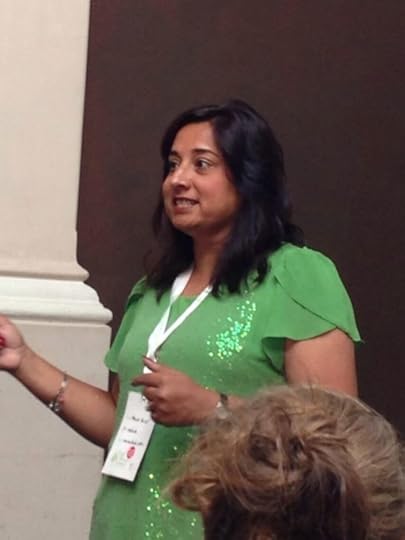

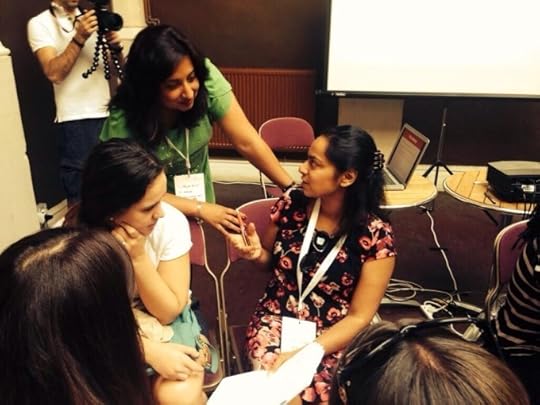



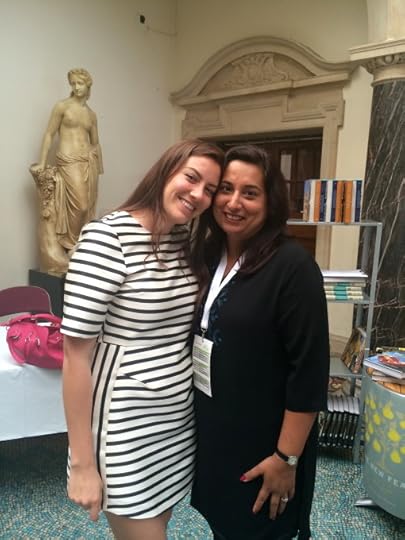



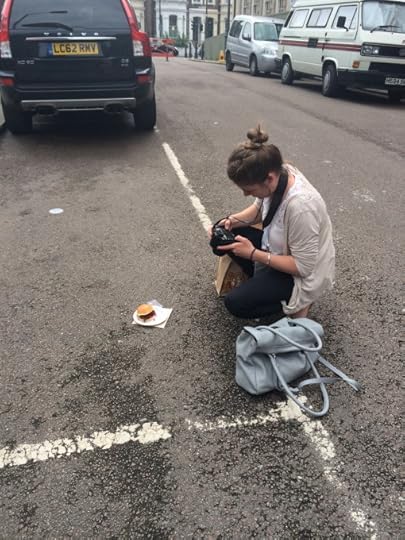
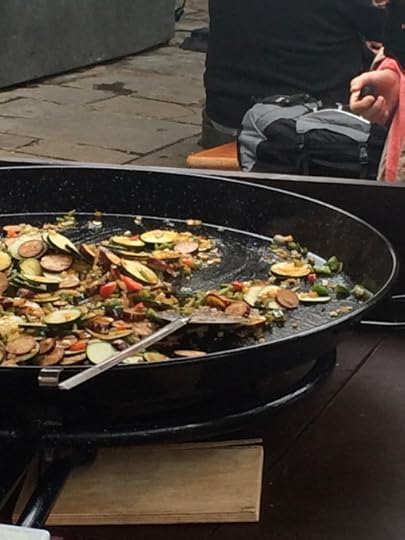
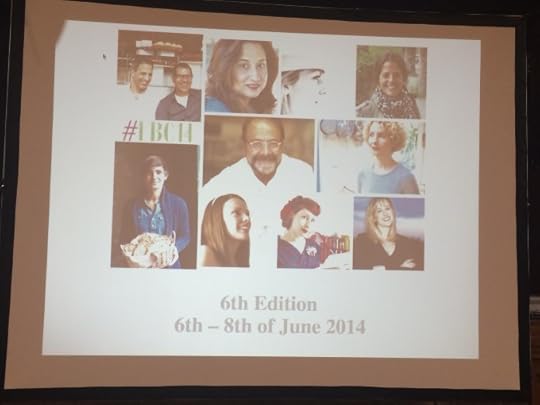
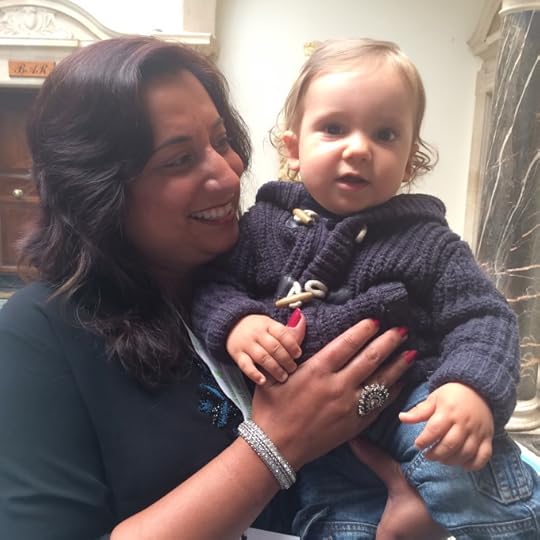
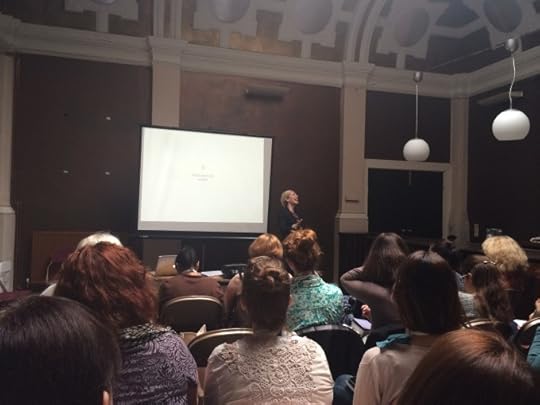

 A
A
The post Food Bloggers Connect Conference 2014, London appeared first on Monica Bhide | Indian Recipes, Cuisine, Cooking with Spices.


